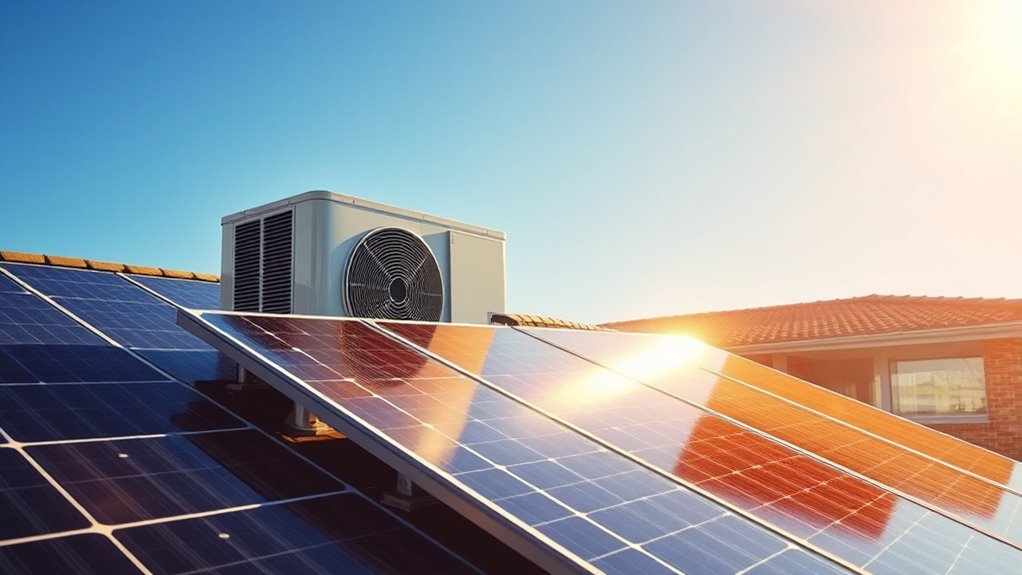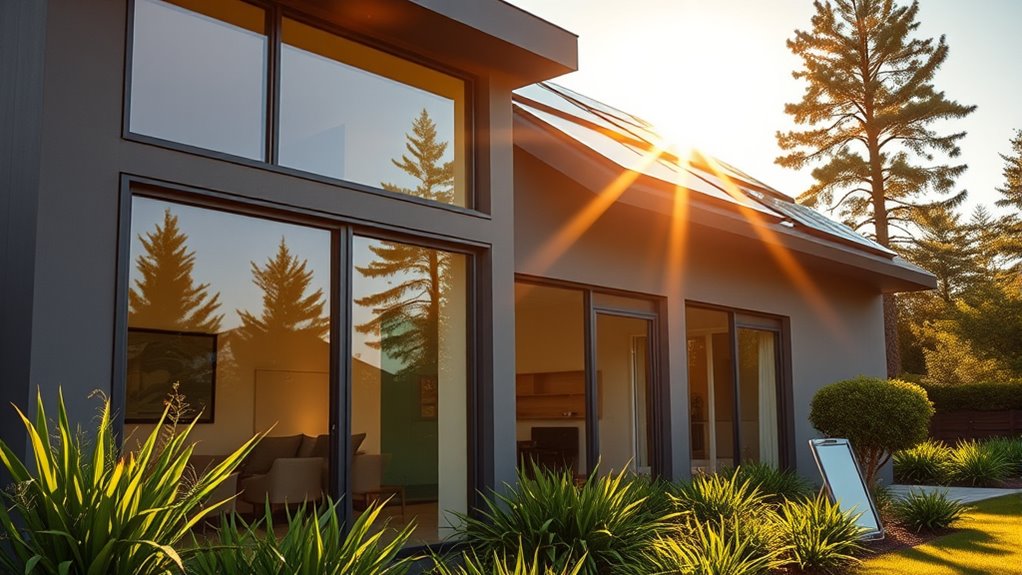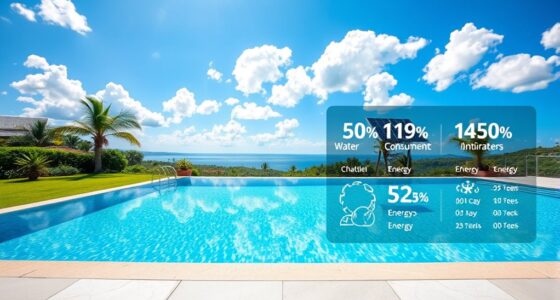To heat smarter, focus on maximizing solar gain by placing large, double-glazed windows facing south, using shading devices for summer, and sealing your home well to trap heat. A heat pump makes sense in moderate climates with good insulation, especially if you want an efficient, renewable heating option. Combining solar strategies with a heat pump can cut costs and reduce your carbon footprint. Keep exploring to discover how to get the most from these methods.
Key Takeaways
- Solar gain depends on window orientation, size, shading, and building materials to maximize natural heat in winter.
- South-facing windows and proper insulation enhance passive solar heating, reducing reliance on active heating systems.
- Combining solar gain strategies with heat pumps can significantly lower energy costs and improve overall efficiency.
- Proper home design, including window placement and shading, optimizes passive solar benefits and prevents overheating.
- Heat pumps are most cost-effective in moderate climates with good insulation and when passive solar heating is effectively utilized.
Understanding Solar Gain: How the Sun Heats Your Home

Have you ever wondered how sunlight naturally warms your home? When the sun shines through your windows, its rays carry energy that warms surfaces and air inside. This process, called solar gain, depends on factors like window orientation, size, and shading. South-facing windows receive the most sunlight, especially during winter, helping to raise indoor temperatures naturally. Materials like brick or concrete absorb sunlight and release heat slowly, providing ongoing warmth. Properly harnessed, solar gain can reduce your heating needs and lower energy bills. However, it’s important to understand how much sunlight your home receives and how your windows and building design influence this process. By optimizing solar gain, you can make your home more energy-efficient and comfortable all year round.
Factors That Influence Solar Gain Effectiveness

Several key factors determine how effectively solar gain warms your home. First, the orientation of your windows matters; south-facing windows typically capture the most sunlight. The angle and slope of your roof can also influence how much sunlight reaches those windows. Additionally, shading from trees, nearby buildings, or overhangs reduces solar gain, so positioning matters. The type and size of your windows play a role too; larger, double-glazed windows trap more heat. Finally, the local climate affects efficiency—areas with more sunny days benefit more from passive solar heating. Understanding these factors helps you maximize solar gain, making your home warmer naturally and potentially reducing heating costs. Proper planning ensures you harness the sun’s energy effectively, regardless of external conditions. Incorporating space optimization techniques can also help in arranging your home to improve solar exposure.
Benefits of Harnessing Natural Solar Heat

Using natural solar heat can considerably cut your energy costs over time. It also reduces your carbon footprint, making your home more eco-friendly. By harnessing this renewable resource, you enjoy both savings and sustainability benefits. Implementing efficient application timing for passive heating can further optimize your energy use.
Cost Savings Potential
Harnessing natural solar heat can substantially reduce your heating costs over time. By capturing free, renewable energy from the sun, you lower your reliance on traditional heating methods and cut energy bills. The savings depend on factors like your home’s size, insulation, and sunlight exposure. Over the years, these reductions add up, offering a significant financial benefit. To illustrate, here’s a quick comparison:
| Method | Typical Cost Savings | Installation Effort |
|---|---|---|
| Solar Gain Use | High | Moderate |
| Heat Pump | Moderate | Moderate |
| Traditional Heating | Low to None | Low |
Investing in solar gain techniques can quickly pay off, making your home more affordable to heat.
Eco-Friendly Heating
Because natural solar heat is a renewable resource, tapping into it helps reduce your home’s carbon footprint and reliance on fossil fuels. By harnessing the sun’s warmth, you make your home more eco-friendly and sustainable. This approach minimizes greenhouse gas emissions and lowers your energy bills over time. When you use solar gain effectively, you’re contributing to a healthier planet while enjoying consistent warmth. Imagine waking up to a home naturally warmed by the sun’s energy, reducing the need for electric or gas heating. You also decrease your dependence on external energy sources, making your home more resilient. Additionally, understanding private placement markets can help homeowners explore strategic investment options in renewable energy sectors.
- Sunlight streaming through windows warms your living space naturally
- Reducing the use of fossil-fuel-powered heating systems
- Lowering your overall carbon footprint and supporting renewable energy efforts
How to Maximize Solar Gain in Your Living Space

Maximizing solar gain in your living space starts with strategic window placement and design. Position windows on the south side of your home to capture maximum sunlight during winter months. Use large, unobstructed windows to allow sunlight to enter and warm your space naturally. Incorporate overhangs or shading devices to prevent overheating in summer while still letting in winter sun. Opt for double or triple-pane windows with low-emissivity coatings to improve insulation and reduce heat loss. Consider window treatments like reflective blinds or curtains to control heat gain and loss. Keep windows clean and unobstructed to maximize sunlight penetration. Engaging in creative practice can help you develop innovative solutions for designing energy-efficient windows and shading strategies. By thoughtfully designing and positioning your windows, you can substantially boost solar gain, reducing your reliance on supplemental heating and making your home more energy-efficient.
When a Heat Pump Is a Cost-Effective Heating Solution

A heat pump becomes a cost-effective choice when its energy efficiency benefits outweigh installation costs, especially in moderate climates. Your local climate plays a key role, as warmer areas allow the system to operate more efficiently and save you money. Understanding these factors helps you decide if a heat pump is right for your heating needs. Additionally, considering the noise levels of modern heat pumps can ensure your system operates quietly and comfortably within your home.
Energy Efficiency Benefits
Have you ever wondered when investing in a heat pump truly pays off? The key is its energy efficiency. Heat pumps transfer heat rather than generate it, making them much more efficient than traditional heating systems. This efficiency can lead to significant savings on your energy bills over time. When your home has good insulation and solar gain, a heat pump can operate at peak efficiency, maximizing savings. Additionally, heat pumps often qualify for rebates and incentives, lowering upfront costs. They also provide consistent heating with less energy, reducing your carbon footprint. Moreover, understanding sound vibrations can help optimize your home’s heating efficiency by promoting better cellular and environmental health.
Climate Suitability Factors
Understanding your climate is key to determining if a heat pump makes financial sense. Heat pumps operate efficiently in moderate temperatures, typically between 40°F and 70°F, where they can extract heat effectively from the air. In colder regions, their efficiency drops, and you might need supplemental heating, increasing costs. However, advances in cold-climate heat pumps now perform well in temperatures below freezing. Consider your area’s typical winter lows; if they stay below freezing for extended periods, a traditional heat pump may not be the best fit. Additionally, local energy prices and climate variability influence cost savings. If your region experiences mild winters, a heat pump can be a cost-effective, energy-efficient solution. Otherwise, you might need to explore alternative heating options. Renewable energy benefits
Comparing Heat Pumps With Traditional Heating Systems

While traditional heating systems like furnaces and boilers have long been the standard, heat pumps offer a compelling alternative by providing both heating and cooling from a single unit. They work by transferring heat rather than generating it, making them more energy-efficient in moderate climates. Unlike traditional systems that rely on fuel or electricity to produce heat, heat pumps draw warmth from the outside air or ground, even in cooler temperatures. This results in lower energy bills and reduced emissions. Additionally, advances in heat pump technology have further improved their efficiency and reliability, making them an increasingly popular choice for modern homes.
Heat pumps provide efficient heating and cooling by transferring warmth from outside air or ground.
- Dual functionality: heat pumps cool in summer and heat in winter
- Energy efficiency: use less energy compared to traditional systems
- Installation flexibility: suitable for various home sizes and layouts
Signs Your Home Is a Good Candidate for a Heat Pump

If you’re considering a heat pump as an alternative to traditional heating systems, it’s important to know if your home is a good fit. Heat pumps work best in homes with moderate climates and proper insulation. You should also have adequate space for outdoor units and wiring. Homes with existing ductwork or electric heating are ideal candidates. Additionally, evaluating your home’s energy efficiency and recent upgrades can help determine if a heat pump will effectively reduce your energy costs and improve performance.
Tips for Combining Solar Gain and Heat Pumps for Optimal Efficiency

To maximize the efficiency of both solar gain and heat pumps, you should strategically design your home to harness natural heat from the sun while minimizing heat loss. Proper placement of windows and insulation plays a key role. Orient your home to face the sun’s path, allowing south-facing windows to capture maximum sunlight during winter. Use shading devices or overhangs to prevent overheating in summer. Ensure your home has airtight seals and good insulation to retain heat.
- Install large, double-glazed windows to boost solar gain without losing warmth
- Use thermal curtains or blinds to trap heat at night
- Incorporate passive solar design features like reflective surfaces and thermal mass
Frequently Asked Questions
How Does Insulation Impact Solar Gain Efficiency?
Insulation considerably impacts solar gain efficiency by reducing heat loss in your home. When your insulation is effective, it keeps the warmth from solar heat trapped inside, making the most of the sun’s energy. Poor insulation allows heat to escape, wasting solar gain. So, by upgrading your insulation, you maximize solar benefits, maintain consistent indoor temperatures, and lower your energy bills, ensuring your home stays warm and energy-efficient.
Can Solar Gain Reduce Heating Costs in All Climates?
Yes, solar gain can reduce heating costs in many climates, but not all. You benefit most in sunny, moderate, and temperate zones where sunlight is plentiful and cold extremes are rare. In colder, cloudier regions, solar gain’s impact decreases, and you might need supplemental heating. So, while solar gain helps cut costs, your climate determines how much it truly saves you.
What Maintenance Is Required for Solar Gain Systems?
You should regularly clean your solar gain system’s windows or panels to remove dust and debris, guaranteeing maximum efficiency. Check for any shading obstacles like overgrown trees or new structures that could block sunlight. Inspect for leaks, corrosion, or damage to pipes and connections, and ensure insulation is intact. Schedule annual professional maintenance to verify system performance and safety, keeping your solar gain system operating at peak efficiency all year round.
Are There Any Zoning Considerations for Installing Heat Pumps?
Think of zoning considerations like traffic signals guiding your heat pump’s journey. You’ll need to make certain your home’s zones are properly divided, with controls that match each area’s heating and cooling needs. Proper zoning prevents energy waste and boosts efficiency. You might need permits or professional assessments to map out these zones. By paying attention to zoning, you direct your heat pump’s energy flow smoothly, maximizing comfort and saving money.
How Does House Orientation Affect Solar Gain Performance?
Your house orientation considerably impacts solar gain performance. If your home faces south, it receives maximum sunlight during the day, boosting passive heating and reducing energy costs. East and west-facing walls get morning and afternoon sun, respectively, but may cause overheating. North-facing sides get minimal direct sunlight, leading to less solar gain. Adjusting window placement, shading, and insulation based on orientation helps optimize energy efficiency and comfort.
Conclusion
By harnessing the sun’s warmth and choosing the right heat pump, you turn your home into a cozy sanctuary. Imagine sunlight pouring through windows, naturally heating your space, while a smart heat pump keeps things comfortable efficiently. When you blend solar gain with modern technology, you create a warm, inviting environment that feels just right—cost-effective and eco-friendly. Embrace these strategies, and let your home bask in the gentle glow of smarter heating.









